This symbol of hope and faith in victory is without doubt one of the most popular French emblems. Although the origin of the cross of Lorraine seems to date back to the 4th century, its history is fascinating. From Jerusalem to Constantinople, from Anjou to Lorraine, follow me on a 2,000-year historical adventure! And as a conclusion, I will explain an amusing anecdote: the scandal of the Lorraine cross in Metz!
👉 Read this page in French on our blog Mon Grand-Est! 🇫🇷
A cross of Lorraine not so from Lorraine!
In 1901, a historian dared to write: “There is no such thing as a Cross of Lorraine”!
In fact, if you do some research into History, you will soon realise that the Cross of Lorraine has very little in common with Lorraine.
You only have to look around you at some European coats of arms to realise this:
The first kings of Hungary (from the 12th century):
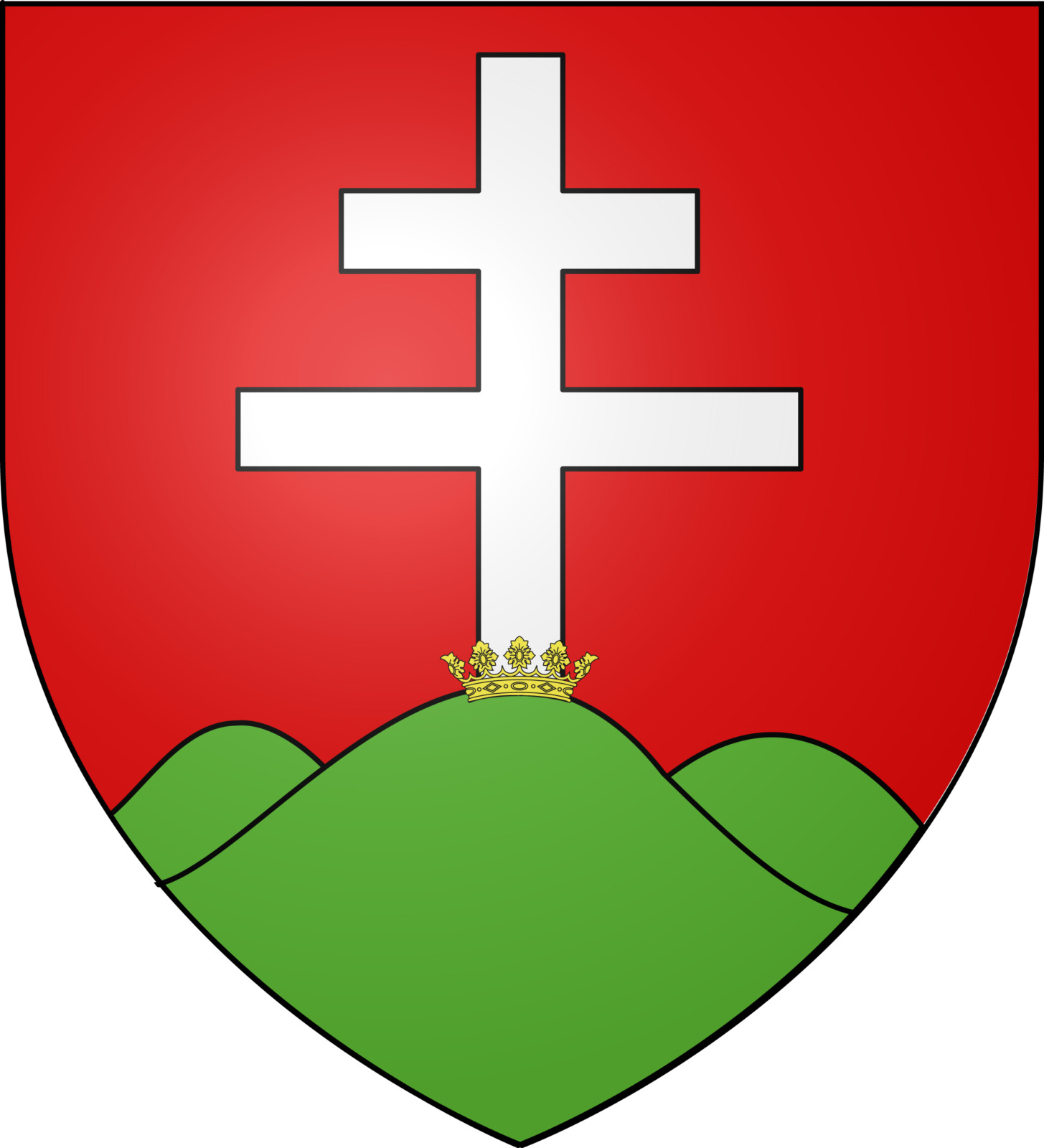
Slovakia:

Lithuania:

And, closer to home, in France, the coat of arms of the Maine-et-Loire département, part of the former duchy of Anjou:

So what is this mystery?
That’s what we’re going to see by going back a long way in time.
At the time of the Crucifixion of Jesus Christ!
Everyone knows the Latin cross, or Christic cross.
From the 4th century onwards, it became the main symbol of Christianity, common to all denominations (from Catholics to Protestants to Orthodox).
It represents the crucifixion of Jesus, which took place around 30 AD.
The cross of torture was shaped like a T. The Romans used to attach a sign to the top of the beam to which the reason for the sentence was written. The Bible tells us that the sign displayed INRI, the acronym for the Latin phrase Iesvs Nazarenvs, Rex Ivdæorvm (Jesus the Nazarene, King of the Jews).
It was not until the 4th to 6th centuries that the cross as we know it took on its recognisable form: ✝
The Patriarchal Cross
Around the year 326, Empress Helena, mother of Emperor Constantine, undertook a journey to the Holy Land.

There, according to tradition, she discovered the holy relics of the Passion of Christ, including the True Cross. That is the cross on which Jesus Christ was crucified.
This was then cut into several pieces to be stored in reliquaries in the form of a cross with two bars.
Why a cross with two bars?
Tradition has it that the upper bar refers to the inscription INRI added by the Romans above the beam of the Crucified One.
Once the double-cross reliquaries were completed, they were entrusted to the rich Byzantine patriarchs.
Thus, until the 13th century, the (alleged) relics of the True Cross were located in Constantinople.
The relics: from Constantinople to Anjou
However, during the 6th Crusade, the relics passed from hand to hand and ended up in France!
At the beginning of the 13th century, Gervais, the Latin patriarch of Constantinople who died in 1219, passed them on to Thomas, bishop of Gerapetra in Crete.
In 1241, he sold them to the lord Jean d’Alluye. In 1244, the Angevin knight brought them back to Anjou to give them to the abbey of La Boissière (Dénezé-sous-Le-Lude) in exchange for 550 livres tournois.
From 1359 to 1388, during the Hundred Years’ War, they were kept in the safety of the Jacobins of Angers.
It was at this time that the shape of the relics – the patriarchal cross – took on the name of the cross of Anjou.
Louis I of Naples (1339-1384), Duke of Anjou, was so devoted to the cross that it was included in his coat of arms.
The dukes of Anjou gave the patriarchal cross a special symbolic meaning by decorating it with gold, rubies and sapphires.
Where are the relics of the Holy Cross today?
Since 1790, the relics have been kept in the chapel of the Incurables at the hospice in Baugé (Maine-et-Loire).
Today, there are a large number of shrines that claim to possess relics of the Holy Cross:
- the treasure of Notre-Dame de Paris,
- the cathedral of Nancy,
- Brussels Cathedral,
- the church of Saint-Sernin in Toulouse,
- the collegiate church of Sainte-Croix in Liège,
- the Coptic Orthodox parish in Sarcelles, etc.
Crosses with crossbars
- In the Middle Ages, the double-cross was also the insignia of the archbishops: it is the archepiscopal cross. Synonymous with the patriarchal cross, the cross of Anjou, the cross of Lorraine.
- The cross with three crossbars was the Pope’s: it is the papal cross.
- Finally, the cross with a single crossbar, the Latin cross, was reserved for religious events.

The cross of Anjou became the cross of Lorraine
In 1473, the great-grandson of Louis I took control of the Duchy of Lorraine.
Duke René II made it the rallying sign for his troops in his fight against the powerful Duke of Burgundy, Charles the Bold (whose attribute was the Cross of St Andrew).
The cross of Anjou was used to invoke God’s protection over the Lorraine armies.
We know the rest of the story (if not, I’ll explain it here!). Charles the Bold was defeated in 1477 at the battle of Nancy.
On the very spot where the Duke of Burgundy fell, René II had a double-cross erected.
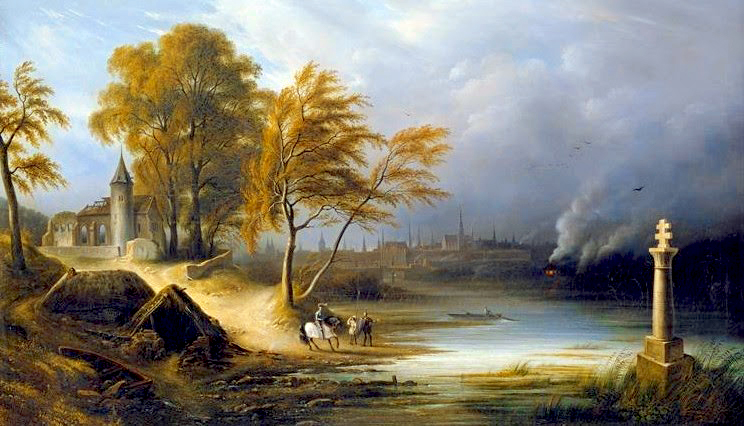
Thus, the cross of Anjou became the sign of the resistance of the Lorraine people during the occupation of the duchy by the Burgundians.
Over time, it even became a symbol of Lorraine’s nationality. (It should be remembered that the Duchy of Lorraine only became French in 1766).
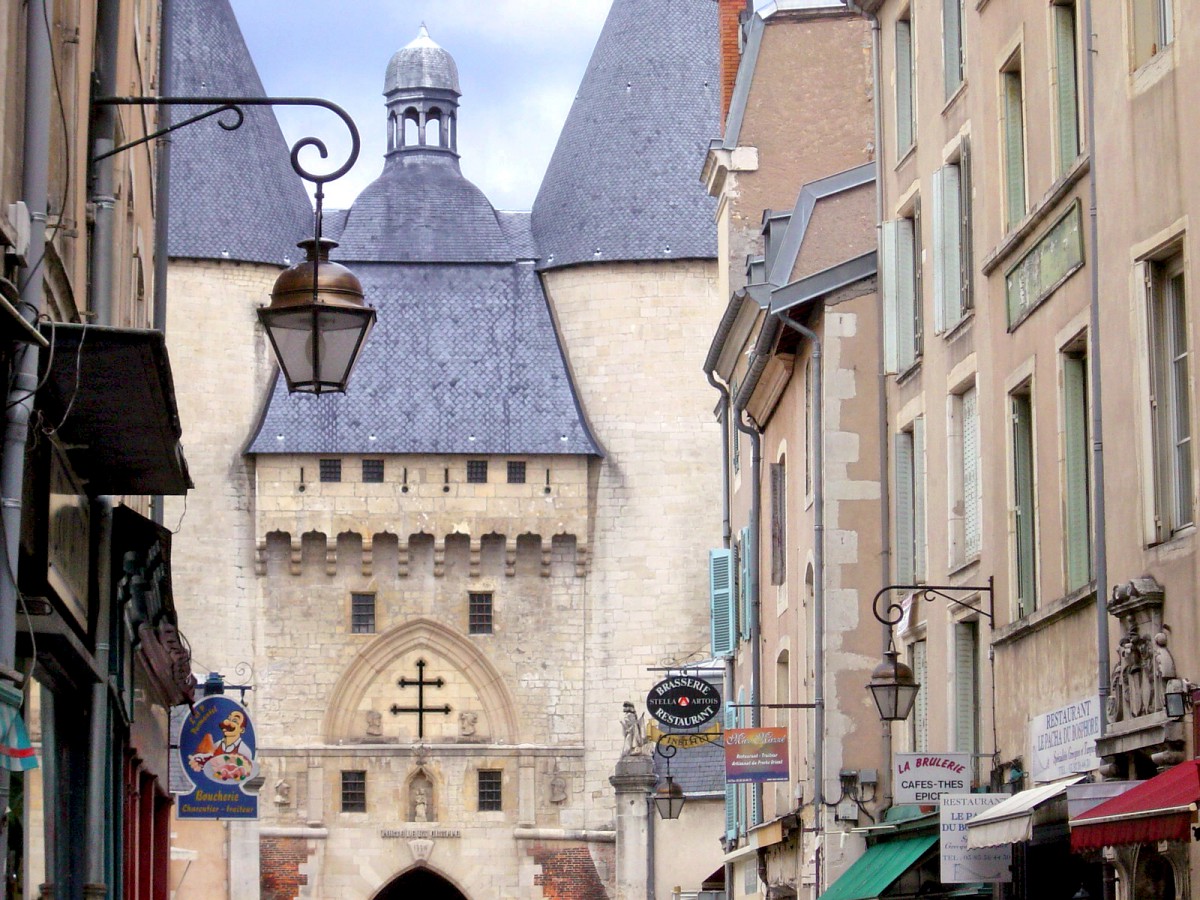
The cross set aside in Lorraine
The dukes of Lorraine Charles V and Leopold continued to include the cross of Lorraine in their banners.
However, with the accession of Stanislas, it was put aside (it did not evoke anything to the former king of Poland).
When the kingdom of France finally got its hands on the duchy of Lorraine in 1766, it was careful not to display a badge that evoked Lorraine patriotism.
However, it reappeared timidly in 1866, during the ceremonies of the first centenary of the attachment of Lorraine to France.
But things were to take a new turn four years later, in 1870.
The Franco-Prussian War
At the end of the Franco-Prussian war of 1870-71, the Lorraine cross became the symbol of resistance and hope for the lost province.
“Thus, since the battle of Nancy in 1477, the double-cross has never ceased to be in the eyes of the people of Lorraine and the French a symbol of hope in misfortune. (Cahiers du “Pays lorrain”, 1948)
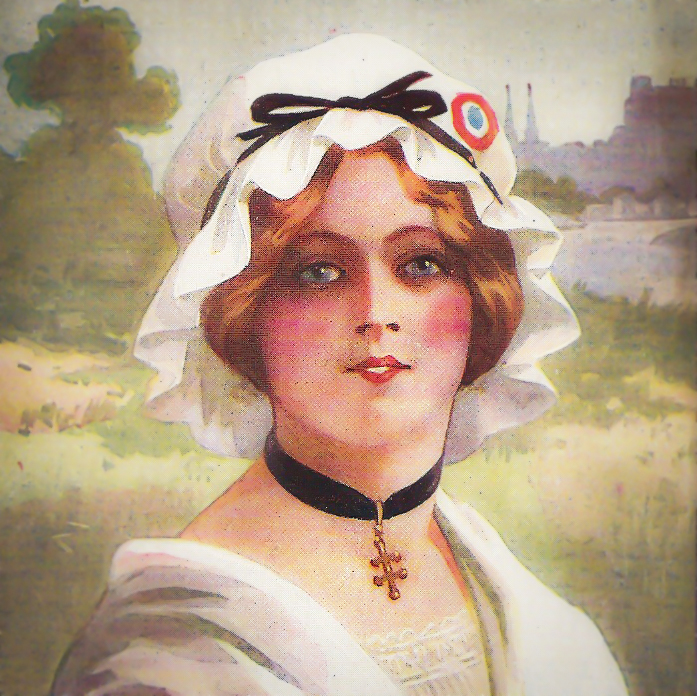
The Nancy artist, Emile Gallé, showed his attachment to the return of Alsace-Moselle by using the Cross of Lorraine in his creations. It can be seen in particular on the famous Rhine table, an allegorical work on display in the Musée de l’École de Nancy.
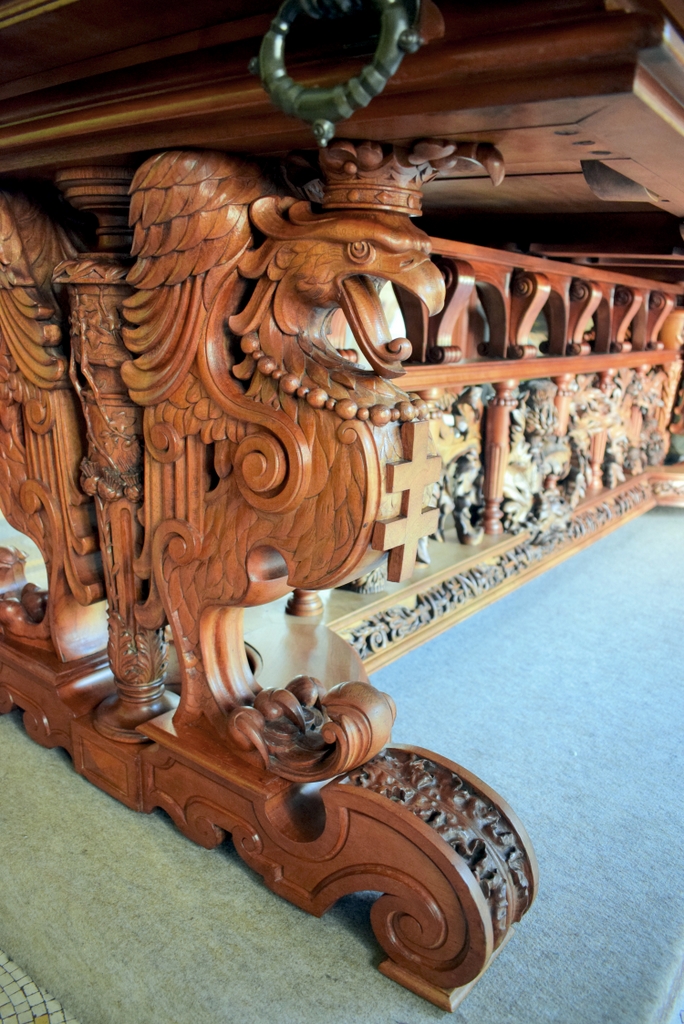
On the eve of the Great War
That said, the provinces annexed by Germany were determined to have their French affiliation recalled.
The unofficial flag of the Reichsland of Alsace-Lorraine, adopted on 25 June 1912 by the Alsace-Lorraine parliament, consisted of the Alsatian flag (red and white horizontal stripes) and a yellow cross of Lorraine on the top left!
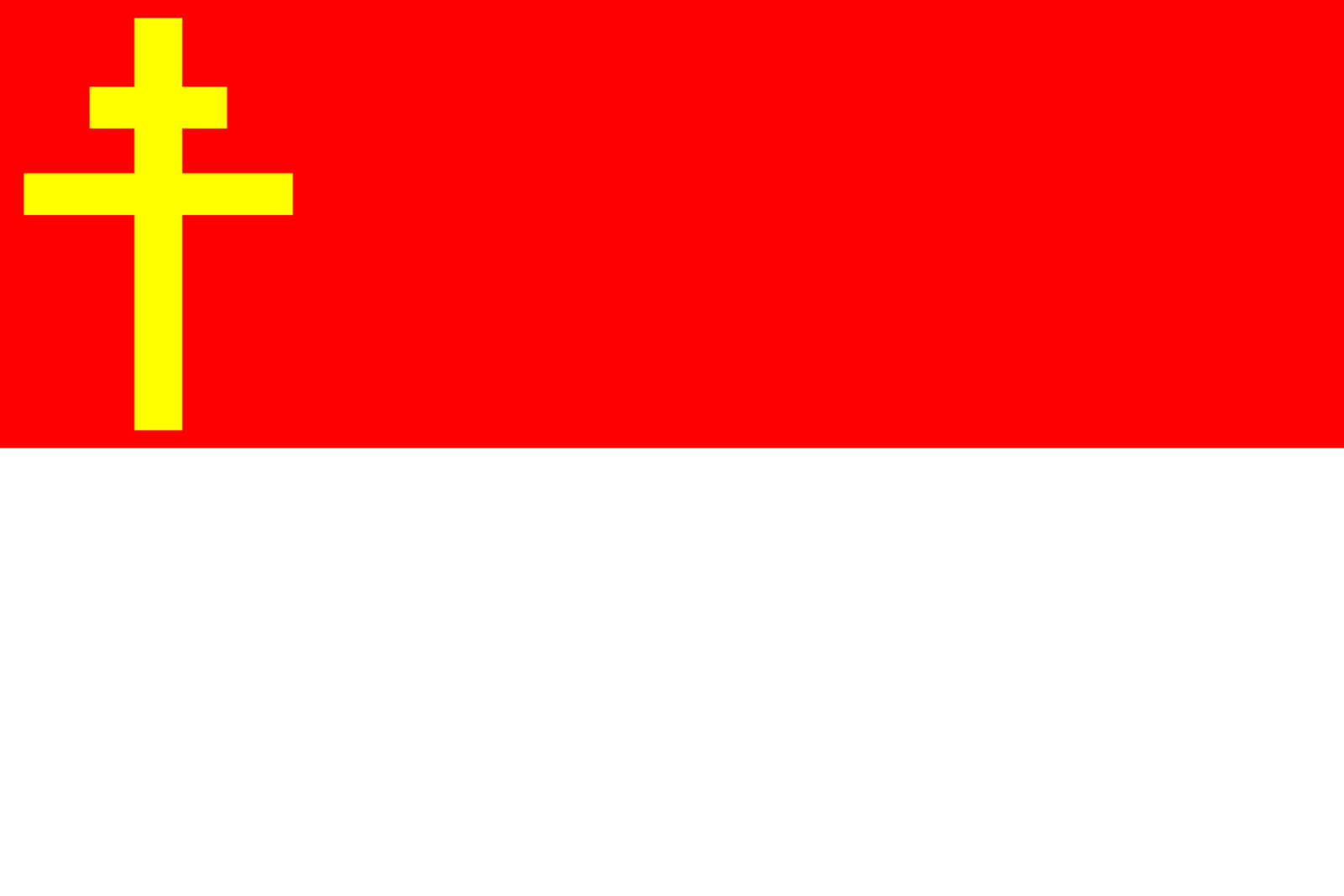
A nice mockery launched to Germany two years before the beginning of the First World War…
The double-cross, a symbol of Free France
But the symbolism of the double-cross was to change greatly during the Second World War.
It became the emblem chosen by the Free French and the French Forces of the Interior. And, thereafter, it remained as a symbol of Gaullism and the French armed forces.
Cross of Lorraine vs. Swastika!
To understand, let’s go back to 1940.
On 1 July of that year, Vice-Admiral Emile Muselier proposed the Lorraine Cross to Charles de Gaulle as an emblem.
The idea was to have an emblem “in opposition to the swastika”.
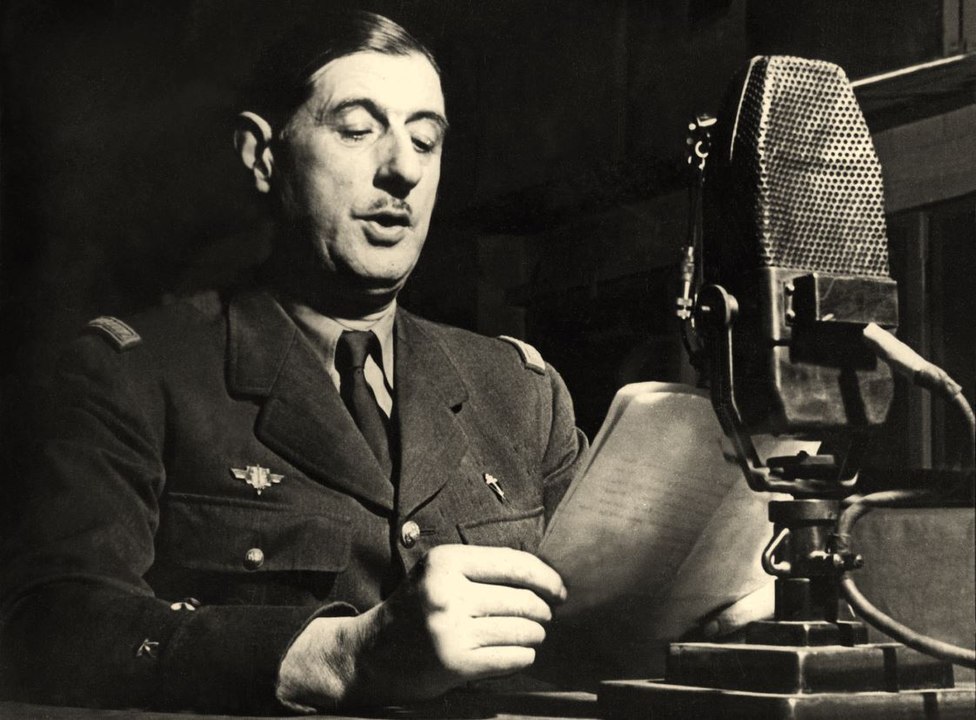
Why did he choose a cross of Lorraine?
Two reasons are given:
- Admiral Muselier was of Lorraine origin,
- the arms of the 507th tank regiment commanded by Colonel de Gaulle in 1937-39 had a cross with two bars.
“The French officers who, in 1940, raised it against the swastika, if they were unaware of the details of glorious history, knew that they were following an ancient and moving tradition. (Cahiers du “Pays lorrain”, 1948)
The emblem of Free France
In occupied France, the Lorraine cross became the emblem of Free France as early as 1940, thanks to BBC broadcasts and parachuted leaflets.
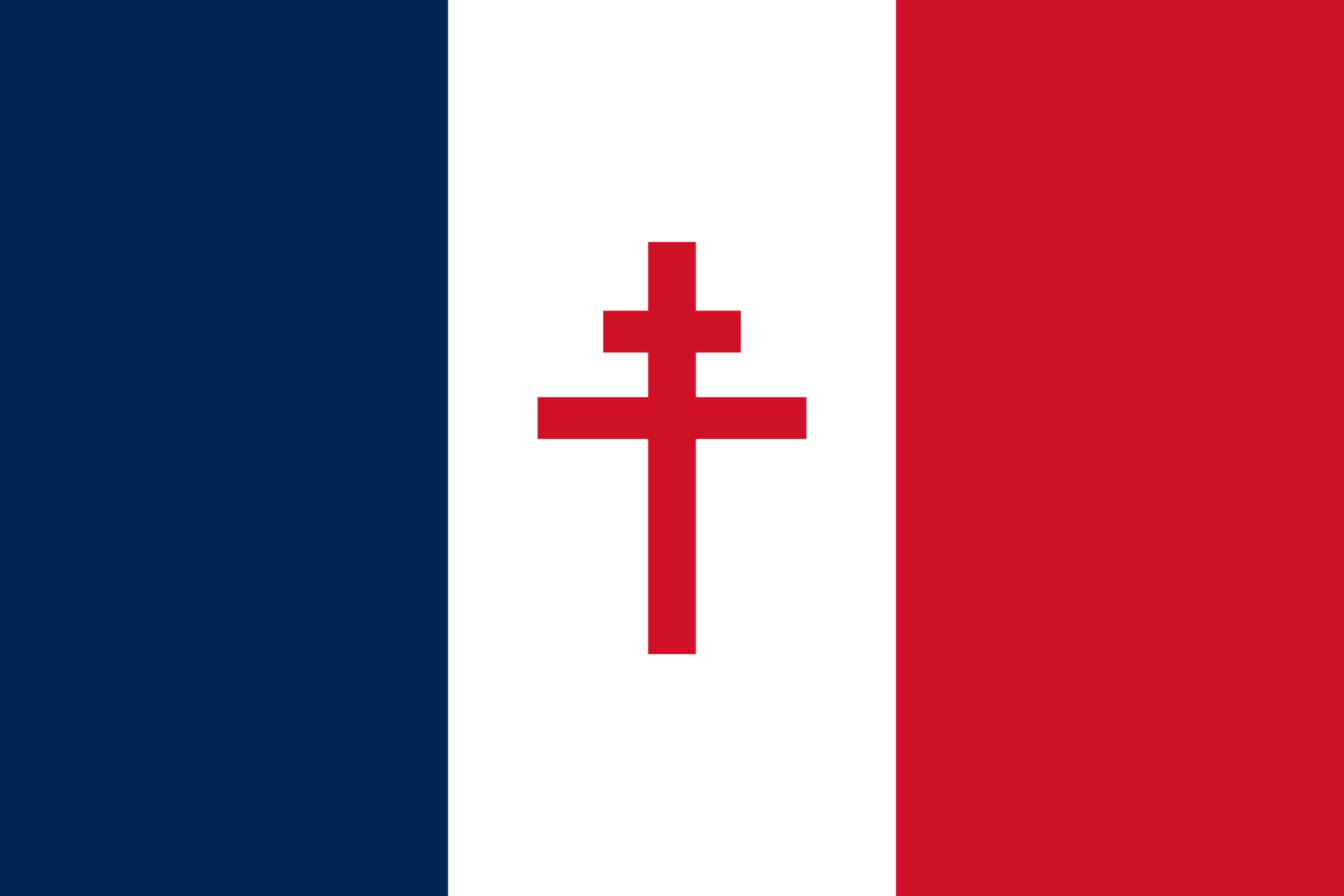
In 1941, the BBC more explicitly encouraged the use of this symbol on the occasion of patriotic events such as 11 November or 14 July.
Then, more generally, the Cross of Lorraine appeared as the symbol of national unification under the aegis of De Gaulle.
Thus, the de Gaulle Foundation evokes in its website:
“What more evocative name for a resistant France than that of Lorraine, the land of Joan of Arc, which has fought so hard throughout its history for its independence! This sign, which is so easy to memorise and to draw clandestinely, is also opposed to the swastika of the Nazi occupiers. The choice of this symbol was the right one: it will unite the whole of the Resistance from outside as well as from within.”
The double-cross after the war
After the war, the Lorraine cross can be found on many :
- French war memorials of the Second World War and
- commemorative coins in honour of the French Resistance.
For example, an 18-metre long cross can be found on one of the Normandy landing beaches. Dating from 1990, it was placed on the spot where General de Gaulle landed on 14 June 1944, between Courseulles-sur-Mer and Graye-sur-Mer. On that day he crossed the English Channel in the French ship La Combattante.

The Cross of Lorraine and Gaullism
Today, when we see the cross with two crossbars, we associate it with Gaullism.
Especially if you are not from Lorraine.
Logically, the political recovery of the cross of Lorraine was seen in all the major political movements that emerged from Gaullism. They took the famous cross as their logo. Thus, from 1947 to 2002, the RPF, the UNR, the UDR and the RPR followed one another. Finally, the UMP, which brought together the Gaullists of the RPR in a great union of the right and the centre, did not take the Cross of Lorraine as its symbol.
Much more recently, in September 2018, President Emmanuel Macron added a Lorraine cross to the emblem of the Élysée Palace, in the centre of the lictor beams. The right-wing gnashed its teeth! 😬

The Charles de Gaulle Memorial
One cannot talk about the Cross of Lorraine without mentioning the Charles de Gaulle Memorial in Colombey-les-Deux-Eglises. This small village in the Haute-Marne département, where the former president lived, has been dominated since 1972 by a monumental double-cross.
Several million people contributed to its financing.
67 foreign countries joined in the undertaking, in particular, Lebanon (with a donation of 1,000 Lebanese cedars that were planted on the hill).

The cross is the work of architects Marc Nebinger and Michel Mosser. It takes the form of a cross made of reinforced concrete. Covered with a pink granite facing from Perros-Guirec in Britanny, it is dressed with bronze surfaces.
It is 44.30 metres high and weighs 950 tonnes (without foundations).
The scandal of the Cross of Lorraine in Metz
Finally, here is a little Lorraine anecdote!
In 1521, the bishop of Metz was none other than Jean de Lorraine, son of Duke René II.
The people of Metz were not very happy about this appointment. It naturally provoked some discontent. Indeed, the people of Metz were proud and jealous of their independence.
But now the bishop had a Lorraine cross affixed to a stained glass window in Saint-Etienne’s cathedral.

Sacrilege protested the people of Metz!
The presence of the emblem of the Duke of Lorraine in the heart of the city gave rise to violent protests, “great noise and tumult“, to use the expression of a local chronicler of the time.
The people of Metz saw this as an intolerable encroachment by Nancy on Metz.
Times have changed, and today it is the Football Club de Metz that proudly displays the cross with two crossbars on its logo, to the right of the Graoully!
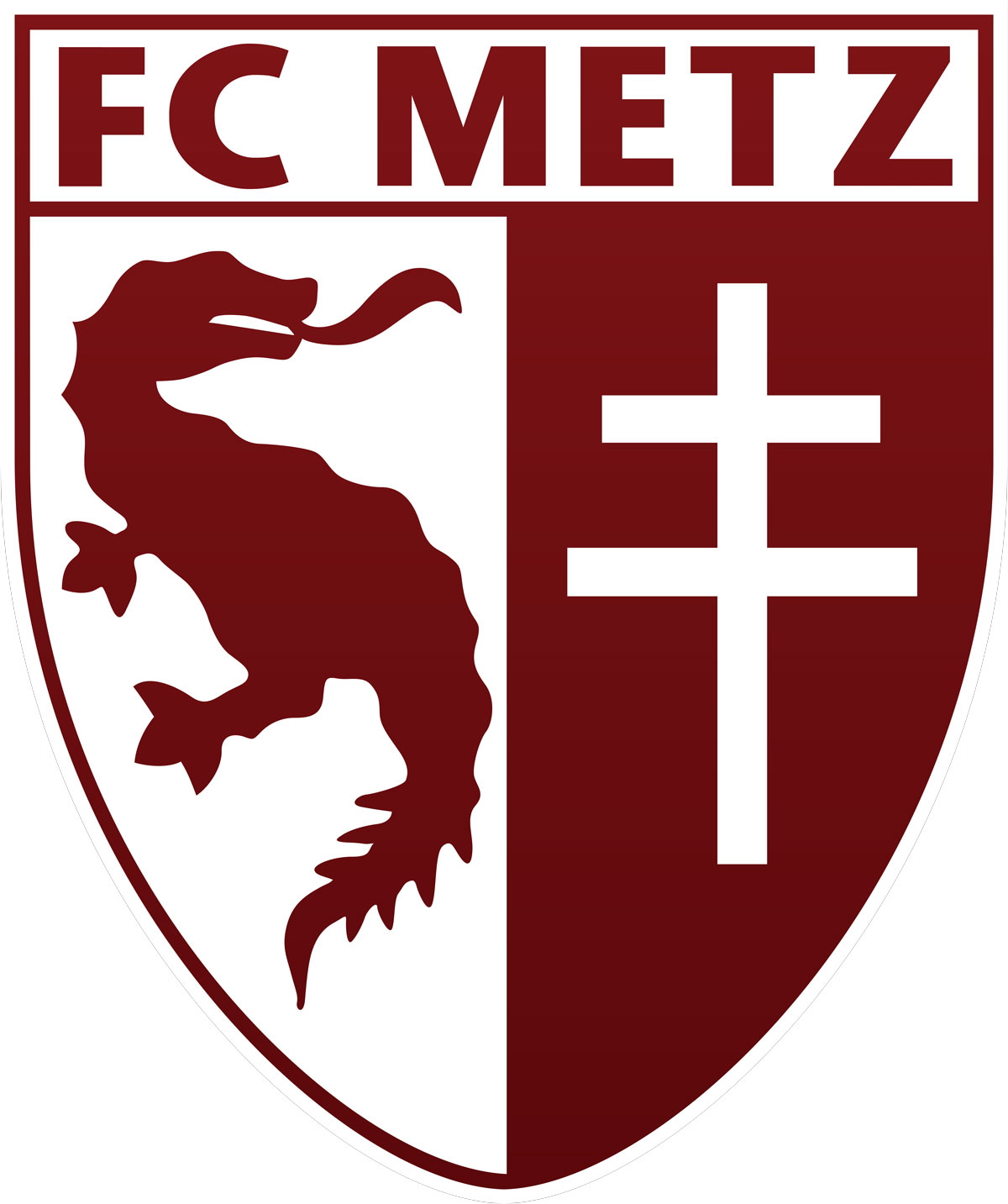
What do you associate the cross of Lorraine with? Tell me all about it in the comments below!
👉 Read this page in French on our blog Mon Grand-Est! 🇫🇷
A pin for Pinterest
Liked what you read? Pin it on Pinterest:





Monsuir Pierre, I am Paul Andre Jeannides, my.mother was born in Paris in 1926 Madeleine P. Vassart, her mother was Georgette Bodson Vassart, her father was Andre Vassart, her Dad was a engineer at Renault, Andre died of Tuberculois, when Madeleine. Was 13 yrs old. My mother married Paul Francis Jeannides. Late June 1945. Paul F, my was and American Sargent us army, landed at Omaha Beach June 6, 1944. Dad married Madeleine after ww 2 ended late June 1945. Both parents have passed away. I have a deep love of France and it’s history due to my mother’s teaching to me as child. The cross of Lorraine is a symbol I hold in my heart, for all free french, and general Degaulle, & general LeClere. And so many others who sacrificed during 1940 thru June of 1944 under German.occupation. Best regards Paul A. Jeannides. Lake Forest ,Illinois. 25 miles north of Chicago Illinois, along Lake Michigan. Joyeux Noel
Thank you very much Paul for sharing your family memories! Glad to hear my article inspired you! Joyeux Noël!
My father served in the US Third Army under the direction of General Patton. His unit wore the Cross of Lorraine on their American uniforms. I have a photo of the patch which I will send you via email. He landed on the Normandy beaches and fought right through Alsace-Lorraine during WW II.
Viva La France!
Amazing, thank you Kathryn. Looking forward to receiving your email with the photo! 🙂
It was very significant to read your comment after reading the article. I studied Gen. Patton on my own in high school (I watched the movie "Patton" several times, which inspired me to read his memoir, "War as I Knew It"). Thank you for sharing.
Thank you for the history on the Cross of Lorraine now I have more clarity concerning what I saw in a vision❤
My mother gave me her cross of Lorraine broach. She lived most of her childhood in Guebwiller and then immigrated to South Africa in 1956.
I guess this broach must be very precious for you! Have a nice day!
I wish I could attache a picture, in 2015, I went detecting and found a 19th century pendant cross, the following day I went out with my friend Ray , sadly no longer with us, he found a cross of Lorraine, we had not seen anything like it, it was a silver gilded cross, about 4cm , x 2cm by 0.5cm thick, we reported to the Portable antiquities Scheme, it was declared treasure, 2 years later the British museum disclaimed it, written on the bale were the LETTERS +A+G+L+ ,it turns out it is an abbreviation fo AGLA which means ( Thou Art Mighty For Ever Olord) it the medieval period it was thought to have magical powers, it dates from 1200-1400 ad.
Wow, that’s fascinating, thank you for sharing!
Fascinating read!
Bonjour, I am not French, but I studied là langue et coture au lycée and have remained a competent speaker to this day. I didn't know the term "Cross of Lorraine" as a symbol until I came upon it in a fictional setting, but I recognized it immediately as 'The Patriarchs' Cross', and the second bar as you explain it was exactly what I thought, the sign that Pontius Pilate affixed to the cross of Christ, which the Pharisees asked him to refrain from labelling as he did. (One of the greatest moments in history and literature IMO; "What I have written, I have written.") I had no idea it became a symbol of provincial nationalism and cultural identity, nor did I know that the Free France movement had its own flag! DeGaulle's choice of emblem was very portentious, one even might say providential. And to think it all rose up around a tradition about emperor Constantine's mother.
Very fascinating and informative article. Thank you for contributing, I was enriched.
You’re most welcome; thank you for your comment! 🙂
I wear a gold necklace with the Cross of Lorraine inside a heart shape. I understand that my grandfather brought it back from France in WWII.
Après avoir pensé qu'il-y-aurait des liens entre la croix Orthodoxe et la croix de Lorraine j'ai fait mes récherches et j'ai trouvé cette contribution excellente et merci, Pierre pour cela!
J'écris deux blogues sur le sujet de la musique Pop féminine des pays de l'ancienne Bloque Soviétique le blogue en générale – 'Girls Of The Golden East' et le Blogue-Fan pour la chanteuse/actrice slovaque-hongaroise, Valérie Čižmárová, 'Bananas For Breakfast' et c'est bien impressionant que les croix hongaroise et slovaque sont ici mentionnées. Pendant sa carrière d'enregistrement les années 1972 à 1974 étaient un temps especialement fort. C'était aussi le temps où j'étais élève à l'école de Herbert Strutt à Belper – renommée pour les acteurs Sir Alan Bates et Timothy Dalton – et le blason de l'école à ce temps-là contenait la croix Orthodoxe/de Lorraine.
Je viens de Derbyshire mais pendant mes années teenager j'ai «adopté» le club de foot, Norwich City – je m'appelle le «Derbyshire Canary»! – et le club slovaque, MŠK Žilina, qui a les mêmes couleurs de jaune et vert, a aussi la croix Orthodoxe sur son blason, précisement comme FC Metz. C'est aussi le cas du blason de la Ville de Žilina, la ville natale de ma Slovaque «Numéro Deux» derrière Valérie Čižmárová, Helena Blehárová. J'ai naturellement aussi «adopté» les «Canaris» de France, FC Nantes!
Merci beaucoup Christopher! L’histoire de ces croix est en effet pleine de surprises ! 🙂
Mais oui!…et c'est rien a remercier.
Un weekend mélangé – les «Canaris» anglais ont gagné contre les «Rouges-Gorges» de Bristol City. Les «Canaris» français ont aussi gagné lorsque nos rivales, Stade Rennais ont perdu. Mais les nouvelles du supporter de FC Nantes, tué au weekend sont pas du tout bienvenues. En une telle contexte le foot signifie rien.
My great aunt was awarded an 18 karat cross of Lorraine necklace for her service in France during world war 1. She was in charge of 87 American nurses sent overseas from the United States. I had the necklace appraised and the appraiser said I should check with the French Government because it may have a much higher value from their perspective. I’m not selling but do want it covered by insurance. I can prove that it is authentic. Would you happen to know if the appraiser is correct in his assumption that it may have significant value to the French government?
Hi Ruth, thank you for your message. It’s possible that the Cross of Lorraine necklace awarded to your great aunt for her service during World War I could have historical and cultural significance, especially considering its connection to American nurses serving overseas. This significance could potentially increase its value from a historical and collectible standpoint.
However, whether the French Government would assign a specific value to it is uncertain. It’s recommended to consult with a historian or an expert in military memorabilia, particularly those specializing in World War I and Franco-American relations, for a more accurate assessment.
Unfortunately, I don’t know who to contact.
Maybe a good start would be to reach Historical Societies like the American Historical Association or similar groups in France that focus on World War I history.
And also consult with Military Memorabilia Experts and seek out dealers or appraisers who specialize in military memorabilia from World War I. They might be found through online directories or military museums.
I hope this helps!
Pierre
Associate the Cross of Lorraine with the Historic Catholic Church in New Orleans Louisiana
Great article, varied histories well told.